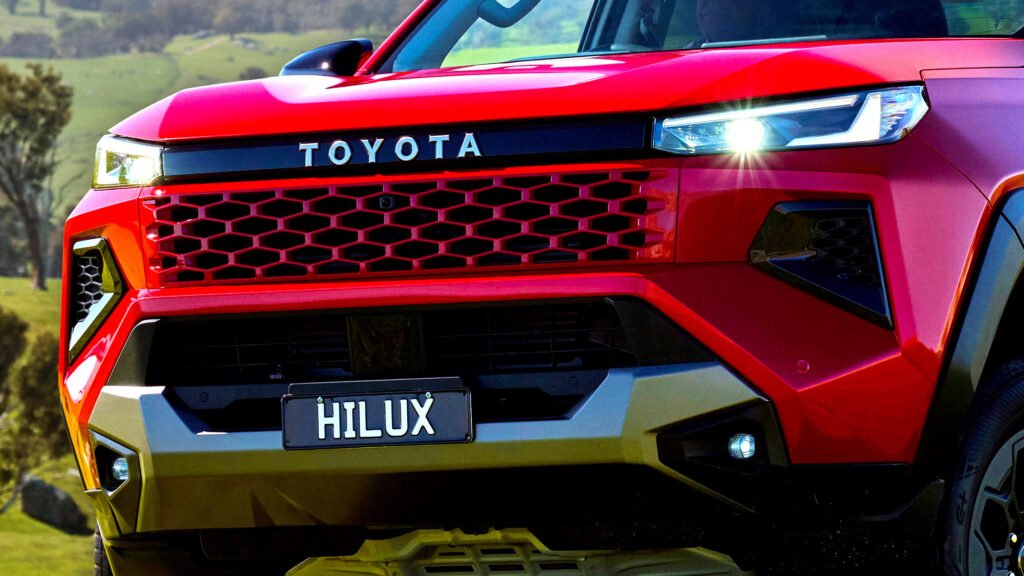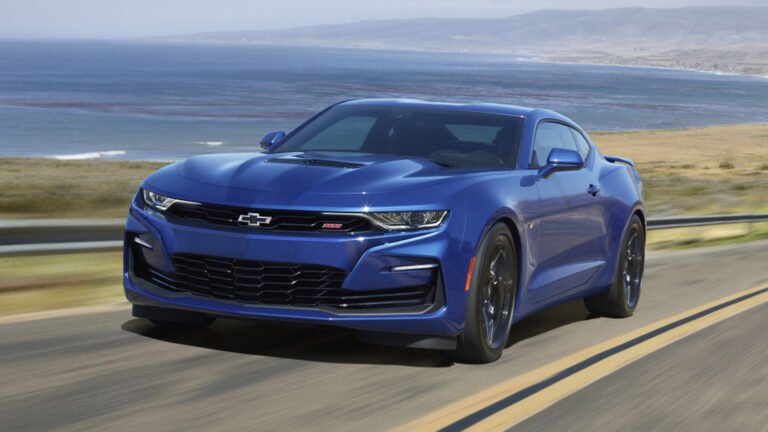

- Toyota Hilux debuts with major design and powertrain upgrades.
- Offers diesel, gasoline, mild-hybrid, BEV, and future FCEV options.
- Launches first in Europe and Australia, then Asia and Japan soon.
While the Ford F-150 dominates North America, the Toyota Hilux continues to reign just about everywhere else. Now entering its ninth generation, Toyota’s workhorse returns with sharper styling, a thoroughly redesigned cabin, reinforced ladder-frame underpinnings, and, for the first time, a fully electric powertrain.
More: Toyota’s Baby Land Cruiser FJ Looks Retro Enough To Break Your Heart
The new design theme, dubbed “Cyber Sumo,” takes a different path from the hammerhead styling found in other recent Toyota models. Up front, slimmer LED headlights flank a body-colored honeycomb grille, while angular bumper intakes and a solid skid plate add a functional, squared-off presence.
The fully electric version wears a unique front bumper with a closed grille and redesigned intakes, a subtle cue to its zero-emission identity.
The profile remains familiar because the greenhouse, pillars, and doors carry over from the outgoing model that’s been around since 2015. Even so, re-sculpted front and rear fenders with boxy wheel arches, paired with fresh wheel designs, give it a tougher stance.
At the rear, the Hilux shows more definition than before, with sharper LED taillights and a modernized bumper that now incorporates practical side steps similar to those on the Ford Ranger.
Its footprint stays consistent with its predecessor at 5,320 mm in length and a 3,085 mm wheelbase. Toyota has chosen to offer only the dual-cab version in Europe and Australia, while markets such as Thailand retain the Single Cab and Smart Cab configurations.
How Has The Interior Changed?
The cabin has been thoroughly overhauled, blending modern tech with the Hilux’s traditionally utilitarian nature. A boxy dashboard frames a free-standing 12.3-inch infotainment screen (8-inch in the base Thai-spec model) and a 12.3-inch digital instrument cluster (7-inch in lower trims). Importantly, physical controls remain for core functions such as climate and audio, preserving tactile ease of use.
The chunky steering wheel with buttons is borrowed from the Land Cruiser, while the compact gear knob and drive mode selector sit on the center console. Dual storage compartments line the passenger side, and dashboard-mounted cupholders complete the layout.
Toyota has also expanded the Hilux’s safety credentials with a “significantly extended” suite of advanced driver-assistance systems, bringing it in line with the brand’s passenger car range.
Multiple Powertrain Options
Toyota’s “Multipathway” approach to propulsion continues here, and the new Hilux exemplifies it. Depending on the market, buyers can choose from the familiar 2.8-liter turbodiesel engine in regular or mild-hybrid form, as well as a 2.7-liter gasoline option.
The biggest leap, however, is the all-electric version. It uses dual electric motors producing a combined 193 hp (144 kW / 196 PS), powered by a 59.2 kWh battery pack.
Toyota quotes a range of 240 km (149 miles) under the WLTP cycle, or just over 300 km (186 miles) using NEDC standards. It may not rival long-range EVs, but Toyota plans to add a hydrogen fuel-cell variant by 2028.
Payload and towing capacities remain robust: up to 1,000 kg (2,205 lbs) and 3,500 kg (7,716 lbs) respectively for internal combustion models. The Hilux BEV, with its heavier battery setup, carries 715 kg (1,576 lbs) and tows 1,600 kg (3,527 lbs).
Upgraded Underpinnings
Under the skin, the Hilux rides on an upgraded version of the IMV ladder-frame architecture of its predecessor rather than moving to the more modern TNGA-F used by the Tacoma and Land Cruiser.
Still, it benefits from a new electric power steering, new engine and cabin mounts for reduced vibrations, new front rail extensions for improved crash perfromance, and a revised suspension setup.
The suspension setup combines independent coil springs at the front with a rigid rear axle supported by leaf springs. Toyota Australia says there are two distinct calibrations: one tuned for heavy-load and towing performance, and another focused on everyday ride comfort.
More: Toyota Shrinks Its Hilux Champ Into The Super Short Wheelbase
In terms of off-road credentials, the 4×4 versions use a part-time 4WD system with high and low range ratios, now improved with the standard fitment of a rear locking differential and the available Multi-Terrain Select system.
Pricing and Availability
Production remains centered in Thailand, where the diesel-powered Hilux Travo is already on sale, priced between ฿767,000 ($23,700) and ฿1,366,000 ($42,200). The fully electric model starts at ฿1,491,000 ($46,100), placing it at the top of the lineup.
The new Hilux will reach Europe and Australia in December 2025, followed by broader Asian rollouts in 2026 and a home-market debut in Japan by mid-2026. Detailed specifications and pricing for each region will be announced closer to launch.
Toyota


